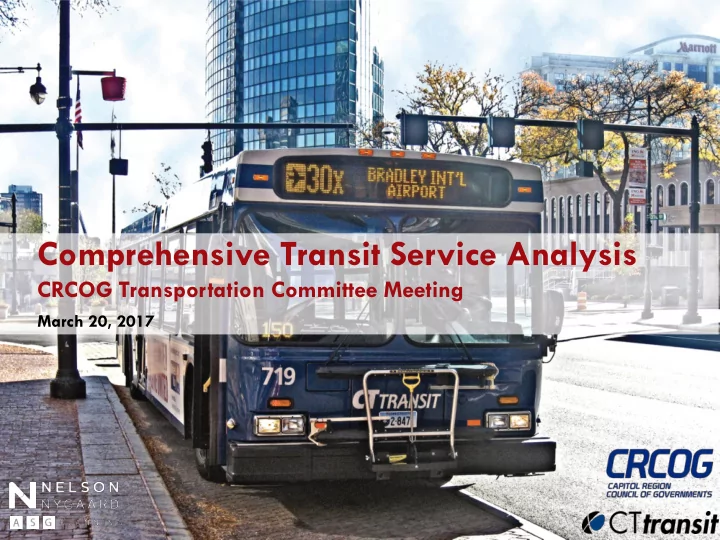

Comprehensive Transit Service Analysis CRCOG Transportation Committee Meeting March 20, 2017
Agenda CSA Overview and Study Approach Stakeholder and Public Outreach Key Findings Recommendations Next Steps New Britain/Bristol Division CSA Overview
Comprehensive Service Analysis (CSA) Identify strengths and weaknesses of existing CT transit Hartford Division – Review current and near-term travel patterns – Assess system efficiency – Identify unmet transit needs Recommend service improvements – Integrate with new system investments – Serve existing riders better – Attract new riders – Improve over-all system productivity
CSA Study Approach What does the market say? – Population and employment density – Population characteristics – Land-use characteristics – Regional travel patterns What do the numbers say? – Ridership – Productivity – On-time Performance What do the people say? – Riders – Non-riders – Staff – Stakeholders
Stakeholder & Public Outreach 6 Advisory Committee Meetings – CTDOT, CT transit , CT rides , GHTD, towns, Travelers, MCC, UConn, CT Coalition for Environmental Justice 5 Focus Groups – CT transit staff, MCC, Spanish Speakers, HYPE, Employers 9 Public Meetings & 5 Rider Drop-Ins – 122 attendees Survey – Available online and in person – 1,080 participants
Stakeholder & Public Outreach Identified Priorities – Access to jobs – Better access to route and schedule information – Regional connections and more crosstown service – Later and more frequent weekday service – Stronger branding and improved service to Bradley Airport Stakeholders and residents are optimistic about future transportation infrastructure investment
Key Findings Almost all areas which can support transit service are already served by the existing system Travel flow data supports the radial design of Hartford’s bus system There is some suburban-to-suburban trip demand There are several strong transit corridors
CURRENT SYSTEM MAP
CURRENT SYSTEM MAP
Recommendations Enhanced Transit Corridors – Targets for greater transit infrastructure such as transit signal prioritization, improved bus shelters, and bus lanes. – Franklin Avenue, Park Avenue, Farmington Avenue, Albany Avenue, and Main Street in Hartford – Burnside Avenue in East Hartford
Recommendations Improved Service to Bradley – Extend the Bradley Flyer down the CT fastrak guideway to New Britain – Rebrand as a CT fastrak route and provide express service along I-91 – Current local service to be covered by local routes – Possible solutions to mitigate parking impact at CT fastrak stations
Recommendations Regional Loop – Combine segments of existing routes to create a regional loop – Allows for suburban-to-suburban trips without transferring in Hartford – Bi-directional service
Recommendations Transportation Network Companies, Flex Service – Uber, Lyft, taxis, flex bus service – Improve first/last mile connections to transit service – Especially effective around proposed enhanced transit corridors – Subsidized TNC service could replace transit in areas that cannot support fixed-route bus service – Need regulatory framework to implement in Connecticut
Recommendations Buckland Hills TOD – Assessed TOD possibilities at the Buckland Hills Park-and-Ride – Low, medium, and high cost options – Devised a plan for routing vehicles throughout the Buckland Hills retail area to allow for bi-directional service – A more in-depth market analysis would be beneficial
Service Design
Impact of Recommendations Service Hours – Increase by 8% on weekdays – Increase by 18% on Saturdays – Increase by 55% on Sundays Weekday Ridership – Increases 9%, from 59,214 currently to a projected 64,644 Service Efficiency – Remains roughly the same, from 265 to 267 riders per hour Cost – Operating expenses proportional to service hour increase
Next Steps Transportation Committee Endorsement of Study Recommendations – April 24, 2017 Finalize Study Report and Executive Summary CRCOG will work with towns, CTDOT, and CT transit to encourage implementation of study recommendations
New Britain/Bristol Division CSA Background – With the addition of Berlin, New Britain, Plainville, and Southington to the CRCOG Region, the CSA scope was expanded to the New Britain/Bristol Division of CT transit ◦ Service currently available in Berlin, New Britain, and Plainville as well as Bristol (NVCOG) ◦ An analysis of the potential for service in Southington is also included in the effort Work to Date – Existing Conditions and Market Analysis – Meetings with towns, CTDOT, and transit providers to discuss potential improvement options – Development of two service improvement scenarios
Existing System
Scenario 1
Scenario 2
New Britain/Bristol Division CSA Next Steps – Public Meetings ◦ April 19, Plainville ◦ April 20, Southington ◦ Rider Drop-Ins to be held in New Britain and Bristol – Develop Recommended Service Scenario – Meet with Towns – Public Meetings – Round 2 (Fall 2017) – Final Report (Winter 2017/2018)
Recommend
More recommend